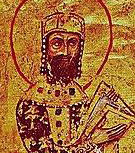
Battle of Levounion(Lebunion) |
year: 109129 April 1091 |
| The Byzantines annihilated a large Pecheneg army | ★ ★ ★ ★ ★ |
|
enemy: Pechenegs
|
location: Levounio, at the delta of Evros river, near Enos (eastern Thrace)
|
accuracy:
●●●●●
|
|
battle type: Pitched Battle |
war: Pecheneg Wars |
modern country:
Turkey |
| ▼ The Byzantines(emperor: Alexios I Komnenos) | ▼ The Enemies | |
| Commander: | Emperor Alexios I Komnenos | Unknown |
| Forces: | 20,000 Greeks, 40,000 Cumans, 5,000 Vlachs | 80,000 (including women and children) |
| Losses: | Annihilated |
| Background story: |
| In the spring of 1087, news reached the Byzantine court of a huge invasion from the north. The invaders were Pechenegs, a Turkic tribe from the north-western Black Sea region; it was reported that they numbered 80,000 men in all. They were most probably in alliance with the Seljuk emir of Smyrna Tzachas (or Chaka Bey). Taking advantage of the chaos that prevailed in Byzantium after the defeat at Manzikert, the Pecheneg horde headed towards Constantinople, plundering the northern Balkans as they went. The invasion posed a serious threat to the Empire, yet due to years of decline and neglect, the Byzantine military was unable to provide the emperor with enough troops to repel the invaders. Emperor Alexios I was forced to rely on his ingenuity and diplomatic skill to save his empire. He appealed to another nomadic tribe, the Cumans, to help him against the Pechenegs. |
The Battle: |
 Emperor Alexios I The Pechenegs appear to have been caught by surprise. The battle that took place on the next morning at Levounion was practically a massacre. The Pechenegs had brought their women and children with them, and they were totally unprepared for the ferocity of the attack that was unleashed upon them. The Cumans and the Byzantines fell upon the enemy camp, slaughtering all in their path. The Pechenegs quickly collapsed, and the victorious allies butchered them so savagely that they were almost wiped out. The survivors were captured by the Byzantines and taken into imperial service. |
Aftermath: |
| It was the single most decisive victory achieved by a Byzantine army for more than half a century and the first victory of the Komnenian restoration. It marked the beginning of a resurgence of Byzantine power that would last for a 100 years. |
|
|
